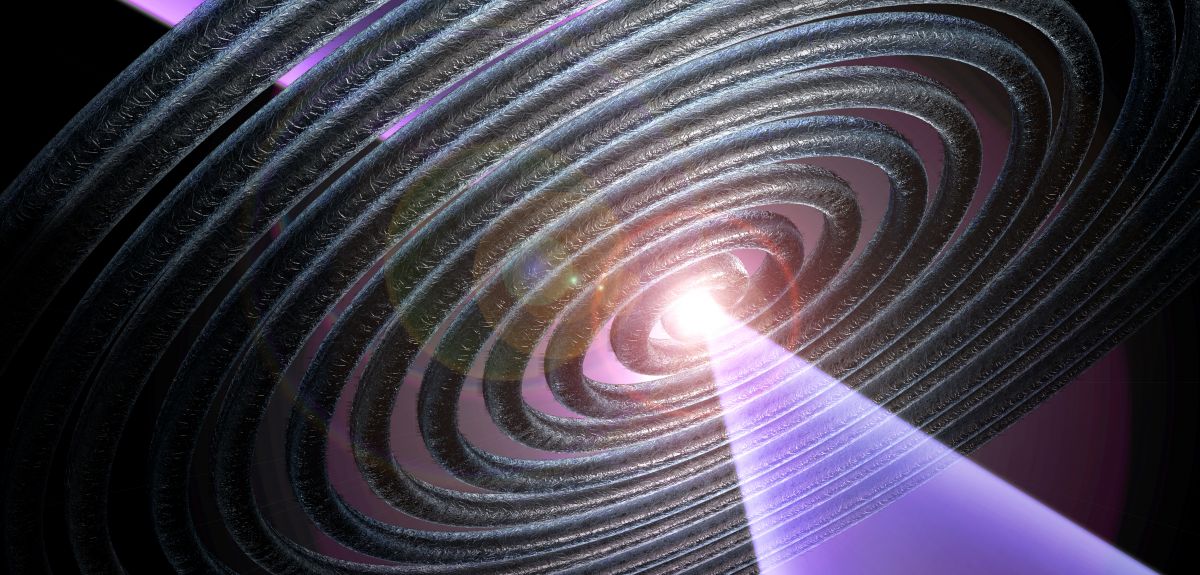
Image credit: Shutterstock
Gravitational waves: Oxford scientists offer exciting insights
Oxford scientists have provided important insights into the latest discovery of gravitational waves.
Today's announcement by the LIGO/Virgo collaboration marks the first time gravitational waves have been detected from the merger of two neutron stars – as well as the first detection of electromagnetic radiation from the same cosmic event.
The scientists behind the original observation two years ago were awarded the 2017 Nobel Prize in Physics for their work. However, until now these 'ripples in the fabric of spacetime', first anticipated by Albert Einstein a century ago, had only been found following the merger of black holes.
An international team led by Dr Kunal Mooley of Oxford's Department of Physics was able to detect the 'afterglow' of these ripples in radio waves, using the New Mexico-based Jansky Very Large Array (VLA) telescope. Thanks to the follow-up of telescopes like VLA, the source of the gravitational waves was pinpointed to the nearby galaxy NGC 4993.
In parallel to the radio detection reported by VLA, the electromagnetic counterpart to the gravitational wave source was also observed by the MeerKAT radio telescope currently being commissioned in South Africa. Observations with MeerKAT were led by a small team including Dr Mooley and his colleague Professor Rob Fender, also from Oxford Astrophysics. When complete, MeerKAT – in which Oxford astrophysicists have strong involvement – will be one of the most powerful radio telescopes in the world.
Meanwhile, the European Space Observatory-funded ePESSTO project, led by Queen's University Belfast and involving Oxford astrophysicist Professor Philipp Podsiadlowski, confirmed that the merging of two neutron stars is accompanied by a transient, supernova-like astrophysical event known as a kilonova. Such phenomena are powered by the nuclear fusion reactions that take place within the material ejected during a neutron star merger.
Animation of the merger of two neutron stars. Credit: NRAO/AUI/NSF
Dr Mooley, principal investigator on the Jansky Array Mapping of Gravitational Wave Sources as Afterglows in Radio (JAGWAR) project, said: 'The discovery of this gravitational wave source and its electromagnetic counterpart has opened up a new avenue of research in astrophysics. Since the elements heavier than iron – such as gold, lead, platinum or mercury – are predominantly produced during neutron star mergers, the study of such mergers across the electromagnetic spectrum allows us to understand how the enrichment of these elements takes place within our Universe.'
The VLA findings are described in a paper published in the journal Science. Dr Mooley, a Hintze Research Fellow at Oxford, added: 'Two months after the neutron star merger, the electromagnetic signal has already faded below the sensitivity limits of most optical telescopes. It is also currently close to the Sun, and therefore radio wavelength observations are probably the only means of getting more information from the afterglow.
'Teams from Oxford, Caltech, Texas Tech and the National Radio Astronomy Observatory are now working together to watch the evolving electromagnetic counterpart with the VLA and other radio telescopes. These observations will provide key information about the environment in which the merger took place, as well as more fascinating details on the neutron-rich material that was ejected.'
Professor Podsiadlowski, co-author of the ePESSTO paper published in the journal Nature, said: 'The discovery of the optical transient event confirmed that the merger of two neutron stars is associated with a kilonova. Kilonovae are powered by the nuclear reactions that occur when the neutron-rich material ejected in the merger decompresses and starts to build up heavy nuclei. This includes neutron-rich elements such as gold and platinum, whose origin has been a longstanding mystery.
'Until recently, many astrophysicists believed that these elements were produced in some type of supernova explosion. But these observations suggest that perhaps all of these neutron-rich elements are produced in neutron star mergers rather than supernovae.'
Professor Podsiadlowski added: 'One question that remains is whether the early detection of a neutron star merger by Advanced LIGO implies that the rate of mergers is much higher than predicted – with important implications for the production of the heavy elements associated with these events – or whether the team was just lucky. This will only be resolved when the detectors operate again in the second half of 2018 after a major upgrade. With increased sensitivity, they should be able to find neutron star mergers on a regular basis.'
 Expert Comment: Chatbot-driven sexual abuse? The Grok case is just the tip of the iceberg
Expert Comment: Chatbot-driven sexual abuse? The Grok case is just the tip of the iceberg
 New study finds that stopping weight-loss drugs is linked to faster regain than ending diet programmes
New study finds that stopping weight-loss drugs is linked to faster regain than ending diet programmes